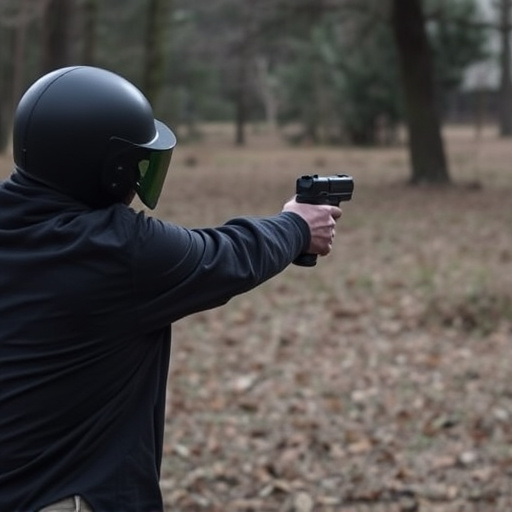Obtaining a non-lethal weapon certification is crucial for responsible stun gun carrying. This process equips users with knowledge of stun guns' high-voltage electrical discharges, temporarily disabling aggressors without permanent harm. Certification programs educate candidates about safe application, legal implications, and risk minimization techniques through comprehensive training scenarios. Understanding the nervous system disruption caused by stun guns—including muscle spasms and temporary paralysis—is essential for effective and safe deployment in self-defense situations. Regular training, staying informed about regulations, and ongoing education ensure responsible stun gun use.
“Uncover the power of non-lethal force with our comprehensive guide to certification. In an era where law enforcement seeks effective yet safe alternatives, understanding non-lethal weapon training becomes paramount. From the science behind stun gun effects on the nervous system to practical training methods and legal considerations, this article illuminates every step. Prepare for your certification journey and stay informed about the benefits and limitations of non-lethal force, especially its impact on nervous system responses, in today’s dynamic law enforcement landscape.”
- Understanding Non-Lethal Weapon Certification Requirements
- The Science Behind Stun Gun Effects on the Nervous System
- Training Methods for Effective and Safe Deployment
- Legal Considerations and Regulations for Stun Guns
- Benefits and Limitations of Non-Lethal Force in Law Enforcement
- Preparing for and Maintaining Your Non-Lethal Weapon Certification
Understanding Non-Lethal Weapon Certification Requirements

Obtaining a non-lethal weapon certification is a crucial step for individuals aiming to carry and use stun guns or other less-lethal force tools responsibly. This process ensures that users understand the unique properties and effects of their chosen device, particularly its impact on the nervous system. Stun guns, also known as electronic control devices (ECDs), deliver high-voltage electrical discharges that temporarily disable an aggressor without causing permanent harm. Certification programs educate individuals on the safe application of such force, including understanding the stun gun’s range, activation mechanisms, and the specific physiological effects on the nervous system that render a subject incapacitated.
The training covers various scenarios and techniques for effective deployment while minimizing the risk of injury or death. Candidates learn about the legal implications and responsibilities associated with carrying non-lethal weapons in their jurisdiction. This comprehensive approach ensures that certified users can make informed decisions, react appropriately during encounters, and utilize these tools as a last resort when facing dangerous situations.
The Science Behind Stun Gun Effects on the Nervous System
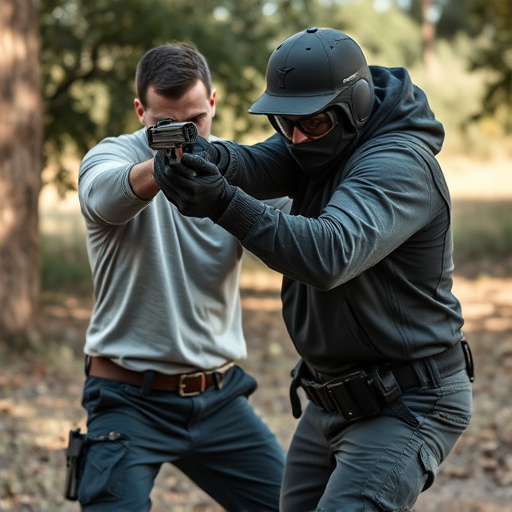
The stun gun, a popular non-lethal weapon, operates by delivering an electric current through the skin to disrupt the nervous system and cause muscle paralysis. This technology leverages the science behind the stun gun effects on the nervous system. When activated, the stun gun generates a high-voltage, low-amperage electrical pulse that interferes with the transmission of nerve signals in the targeted area. The result is immediate pain and temporary incapacitation, allowing users to subdue an assailant without causing permanent harm.
The electric current disrupts the flow of ions within the neurons, leading to a breakdown in communication between them. This disruption triggers a response from the body’s natural defense mechanisms, causing the muscles to contract involuntarily and resulting in spasms or “jolts.” The effects are designed to be non-lethal, with the primary goal being to disable an attacker temporarily, providing individuals with time to escape or seek help. Understanding these stun gun effects on the nervous system is crucial for anyone pursuing non-lethal weapon training certification, as it ensures safe and effective use in real-world scenarios.
Training Methods for Effective and Safe Deployment
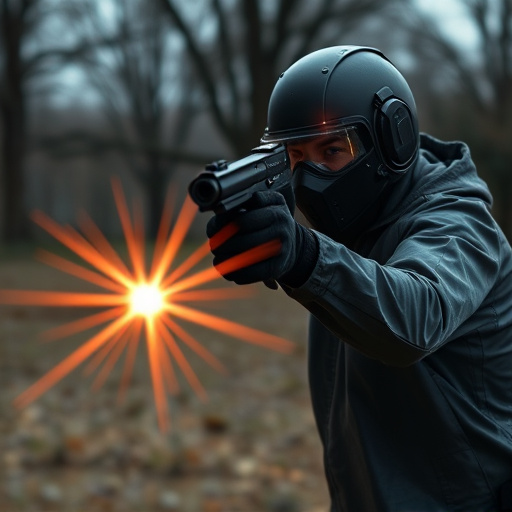
In non-lethal weapon training, understanding the effects of stun guns on the nervous system is paramount for safe and effective deployment. Stun guns, also known as electronic control devices (ECDs), work by delivering a powerful electrical shock that disrupts motor neuron signals, causing temporary muscle paralysis. This disruption occurs through the device’s electrodes making contact with the target’s skin, leading to a series of physiological responses. The shock not only incapacitates the subject but also ensures minimal physical harm, making it a preferred choice for law enforcement and security personnel in non-fatal situations.
Training methods should focus on practical scenarios that mimic real-world applications, enabling practitioners to understand the precise timing and application of stun gun use. This includes learning proper hand placement, trigger control, and awareness of different body types. Additionally, trainees must be educated on the various levels of force and how to assess a situation to determine the appropriate response. Regular practice sessions, both on dummies and live fire ranges, are crucial for muscle memory development, ensuring quick and accurate deployment during high-stress situations.
Legal Considerations and Regulations for Stun Guns

In many jurisdictions, stun guns are classified as non-lethal weapons, subject to specific legal considerations and regulations. These devices operate by delivering an electric current through a conductor (typically metal prongs or probes) into the target’s nervous system, temporarily incapacitating them. The effects of stun guns on the nervous system include muscle spasms, loss of balance, disorientation, and in some cases, temporary paralysis. Due to these powerful effects, their use is regulated by local laws, which often require certification for carrying or using a stun gun legally.
Certification programs typically involve training sessions that educate users about the weapon’s operation, safety precautions, and legal boundaries. This includes understanding when it’s appropriate to use a stun gun and the potential consequences of misuse. Regulations may also dictate the age restrictions, storage requirements, and registration processes for stun guns. It’s crucial to familiarize yourself with these laws to ensure compliance and responsible use.
Benefits and Limitations of Non-Lethal Force in Law Enforcement
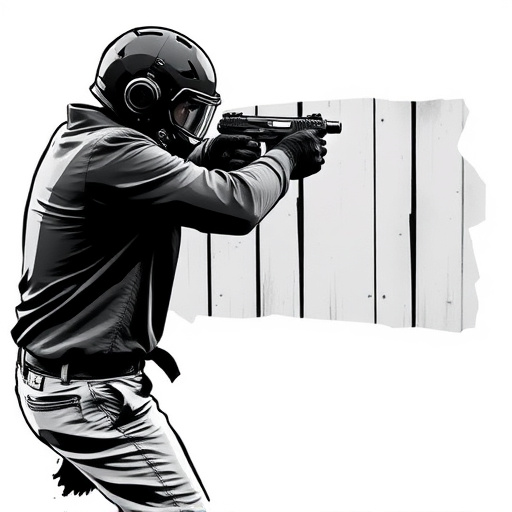
The use of non-lethal force by law enforcement, often in the form of less-lethal weapons like stun guns or Tasers, offers several advantages in modern policing. These tools can help officers de-escalate potentially dangerous situations and control subjects without causing permanent harm or death. For instance, a stun gun’s electric current temporarily disrupts the nervous system, rendering an individual immobile for a short period, allowing officers to gain control of aggressive or volatile individuals. This method is particularly beneficial in crowd control scenarios, where it can be used to subdue and disperse rioters without excessive force.
However, there are limitations and criticisms associated with non-lethal force. While stun guns have minimal risk of causing permanent physical damage, their effects on the nervous system can still result in temporary discomfort, pain, and disability. There are also concerns about potential misuse or over-reliance on these weapons, leading to situations where they become less effective as suspects develop immunity or resistance to the shocks. Additionally, some critics argue that non-lethal force may not always be sufficient against highly aggressive or armed individuals, potentially putting officers and civilians at risk.
Preparing for and Maintaining Your Non-Lethal Weapon Certification
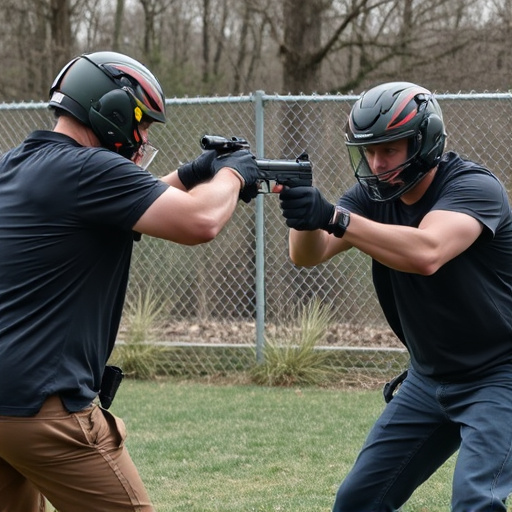
Preparing for your non-lethal weapon certification involves understanding the unique challenges and responsibilities that come with carrying and using such devices. A key aspect to focus on is comprehending the stun gun effects on the nervous system, as these weapons are designed to incapacitate rather than cause permanent harm. Study the scientific principles behind their operation, including the electrical currents they emit and how they interact with the body’s neural pathways, focusing specifically on non-lethal outcomes.
Maintaining your certification requires ongoing education and practice. Regularly review the latest research and guidelines related to stun gun use, as advancements in technology can lead to new insights into their effectiveness and potential risks. Participate in recurrent training sessions to hone your skills, ensuring you’re comfortable with deployment techniques and emergency response procedures. Stay up-to-date with legal requirements and best practices in your jurisdiction to remain a responsible and effective user of non-lethal force.
Obtaining a non-lethal weapon certification is a crucial step towards responsible deployment of stun guns, highlighting the importance of understanding both their science and legal framework. By grasping the effects of stun guns on the nervous system, mastering safe deployment techniques, and staying informed about regulations, law enforcement officers can leverage non-lethal force effectively while minimizing risks. Regular training and maintenance ensure these tools remain a reliable option for de-escalating potentially dangerous situations.
